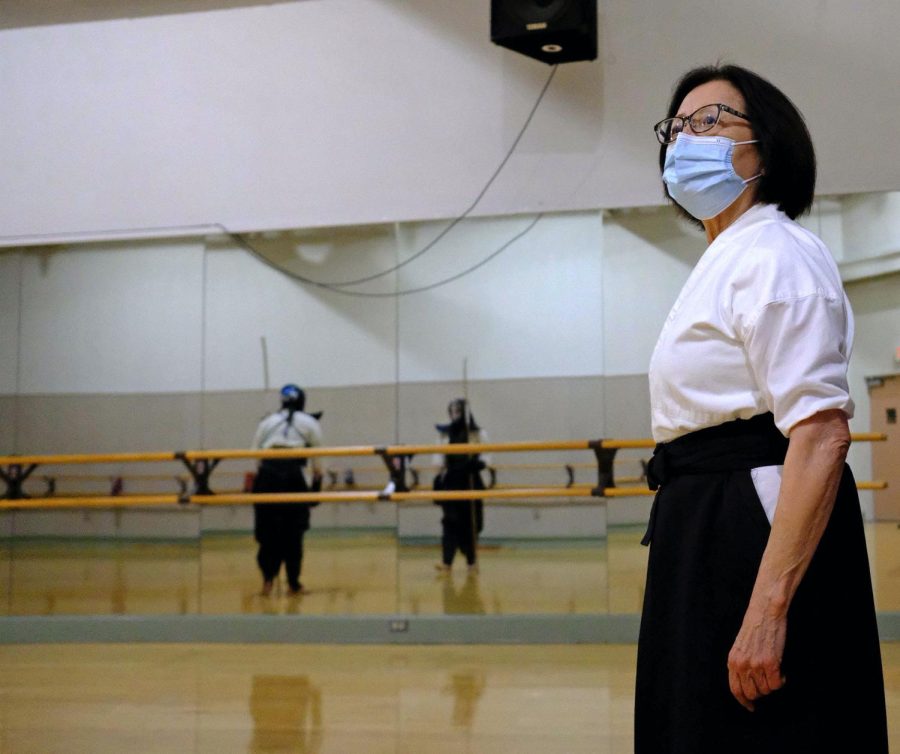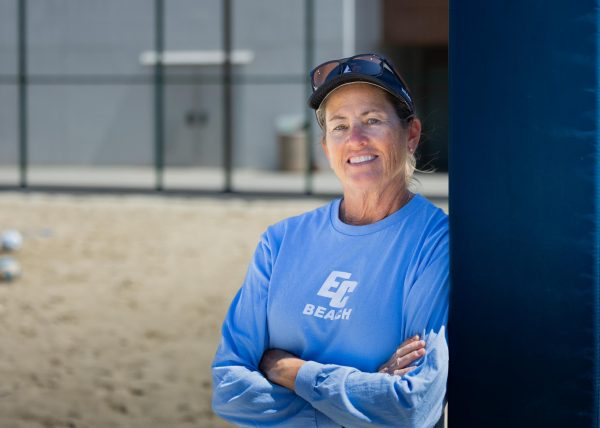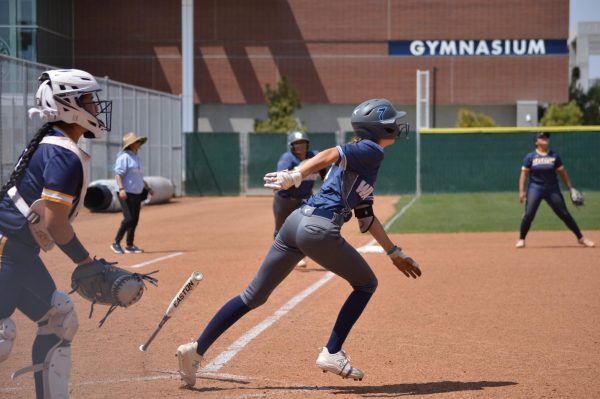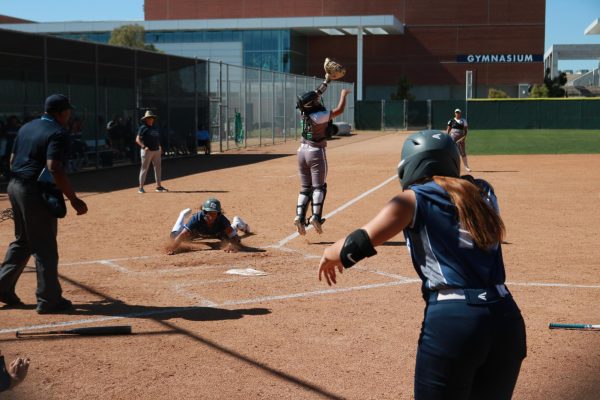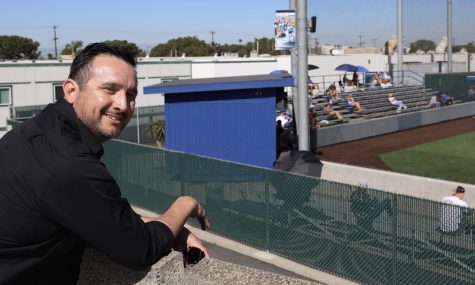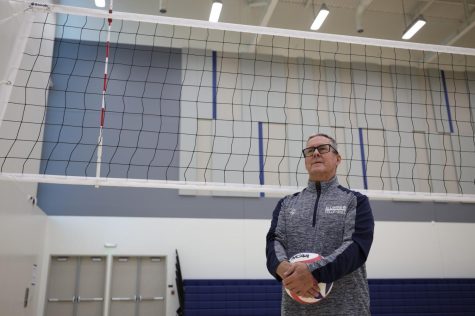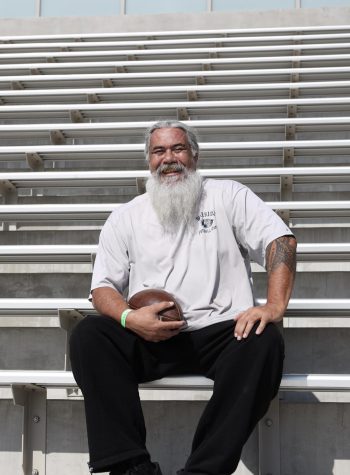Practicing self-care through naginata
Naginata instructor Helen Nakano observes her students during an evening practice at the Japanese Cultural Center in Torrance on Thursday, Oct. 21, 2021. She taught naginata at El Camino College until the pandemic forced her off-campus. Helen was the first-ever teacher to start a naginata class in America. (Jose Tobar | Warrior Life)
In 1966, Helen Nakano went to Japan with her husband George Nakano. George was part of the United States kendo team representing the U.S. in a worldwide tournament that was held in Okinawa.
“I met some naginata teachers that happened to be in Tokyo at another dojo where the kendo people were practicing, and they saw me sitting on the sideline taking pictures of the kendo practice, and they came over and asked me if I’d like to try naginata. At the time I really didn’t have an interest and I just told them I was going to be taking pictures, but they were really persistent,” Helen says.
She was then taken to a dressing room where she dressed up in a white hakama and a white gi. Normally the hakama, the bottom, is usually in a navy blue or black color. Kendo practitioners and martial artists use the same hakama.
Naginata, a pole weapon with traditionally-made Japanese blade, is a budo, or Japanese martial art, which is not a combative art, yet there is a deeper significance to forming a person’s character with naginata. It has a competitive component to it.
Helen, 82, has been practicing naginata ever since that trip to Japan. George is a former California State Assemblyman and was one of the first minorities elected to Torrance City Council. He is an El Camino college alumnus and served as president on the ECC Foundation Board of Directors in 2010.
Prior to visiting Japan, she did not expect her naginata spirit to bloom so quickly.
“When I first started naginata there were no teachers, so we had to learn from a kendo teacher,” Helen says.
She was the first-ever teacher to start a naginata class in America. She was the sensei of El Camino College’s naginata course, which was the only college-accredited course of its kind in the United States.
“I was teaching at ECC up until the Spring of 2020. Because of the pandemic we were shut down and we haven’t been able to start again,” Helen says.

She developed an interest along with Nadine Ishitani Hata. They both learned naginata together and started a class with Torao Mori sensei in Los Angeles.
“[Nadine and I] gradually evolved into becoming the instructor. We’ve had teachers visiting from Japan, annually. And we would teach what we were taught by the teachers from Japan. Probably in late 1966. So by 1970 or 1971, we were teaching, whether we were qualified teachers or not we were teaching what we learned. We were fortunate, we had some excellent teachers that came from Japan that taught us and we also went to Japan to learn so we felt very fortunate,” says Helen.
Nadine Hata was the vice president of academic affairs at ECC until her retirement in 2004. She died of breast cancer in 2005.
The Los Angeles Times reported that Nadine “influenced change not only through her teaching and writing, but also through her work on a state advisory committee to the U.S. Commission on Civil Rights, as chairwoman of the State Historical Resources Commission, and as the only Asian American on the American Historical Association’s 12-member governing council.”
Helen remembers Nadine fondly and the work they had gone through to establish a class at ECC which remarkably turned out to be the only college-accredited naginata course in America.
“Without her, there would not have been naginata at El Camino. I taught in the summer of 1997. It’s as a result of Dr. Nadine Hata. She is the reason I’m able to teach there. She worked really hard to get this class, an accredited class, there,” Helen says.
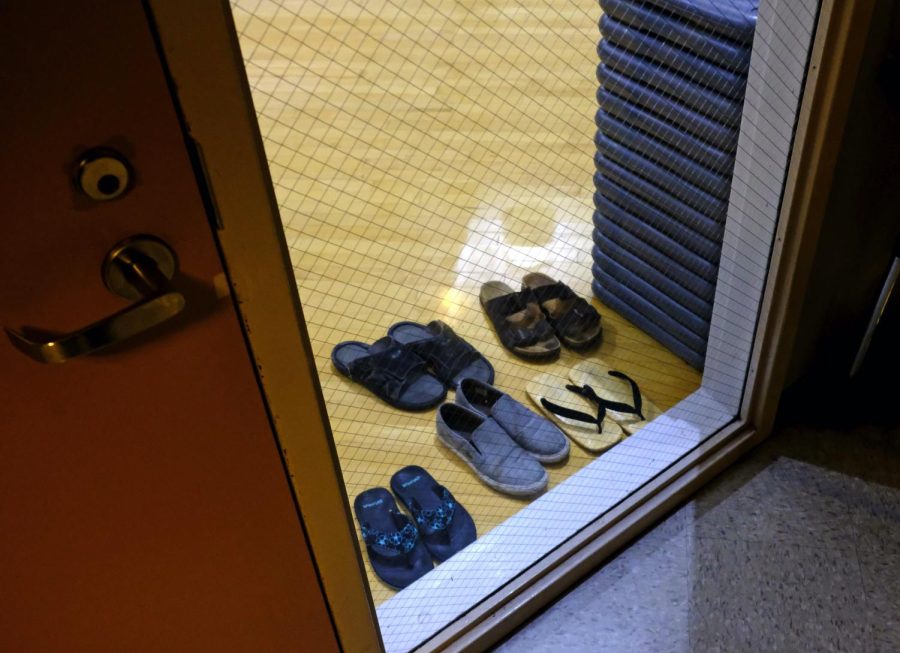
Helen tried to focus less on the sporting aspect of naginata and emphasize more on the character-building aspect of naginata.
“I really love the art form. It made me a better person,” Helen says.
She currently owns four dojos in Southern California and runs dojos in Phoenix, Arizona, and Lincoln, Nebraska.
In 1974 she was one of the founding members of the U.S. Naginata Federation.
In order to keep the keep naginata alive, there needed to be teachers. Helen enjoyed taking the role of a teacher and keeping the spirit of naginata alive.
“At that time, I didn’t have a choice really. I would have preferred being a student all these years. It’s wonderful to continue to, to learn, and taking on the responsibility of being a teacher just happened because there were so very few of us doing it,” Helen says.

Kevin Saxton, 51, a former member of the Torrance Naginata Club and ECC student was practicing kendo in Southern California and went to Canada where he first encountered a demonstration of naginata.
Kevin currently resides in Lakewood, California, and works as an IT administrator for LA county. He is also an instructor for the Irvine dojo.
“The demonstration really interested me,” Kevin says.
Kevin had started naginata in 1990. The thing that piqued his interest was the way naginata can be so grateful.
“The effective use of both sides of your body that with the way that the weapon is used. I felt like by practicing [naginata] it would make my kendo better,” Kevin says.
Kevin said the greatest challenge for him was balancing his martial arts training with the rest of his life.
He had taken a class with a room full of women which he had seen as an equal opportunity.
“Being bigger and stronger is often more of a detriment than a benefit. The most challenging thing would be learning to try to learn to accept that as a man, I can’t move like a woman, but I tried to execute the form gracefully,” Kevin says.
By learning to use this weapon Kevin has learned how to be graceful, to accept things in life that can’t change, and to deal with challenges in life.
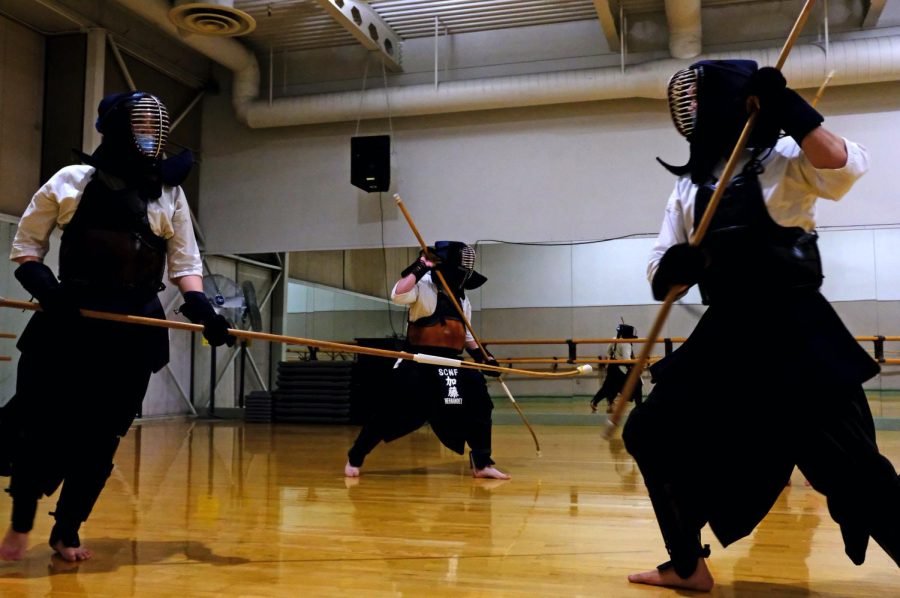
“There’s a Japanese saying, an old Japanese warrior saying that enlightenment is found at the tip of the sword. And basically what that means is when you find somebody all of the things that we often think are so important in life, being cool being like, you know, being rich, good looking, all that goes right out the window. When I find somebody, I get to find out who they are in their heart,” Kevin says.
“Practicing with this weapon helped me become a better man, a better father, a better employee, a better citizen,” Kevin says.
Kevin said his parents were an essential factor in his decision to stick with naginata. His parents always encouraged him to follow his heart.
“Once I found something that I really loved and cared about, that I should do that, there was something I wanted to do, don’t just do it, be the best at it,” Kevin says.
Finding a balance and sustaining the balance is important to Kevin. He hopes to set a good example for his children.
“When it’s their turn to deal with the things, I want them to reflect and [ask themselves], well, what, what did my dad do when things got hard? What did my dad do when things were tough? Did he quit? Just give up? Did he walk away? Or did he face it head-on?” Kevin says.
Kevin describes Helen as a patient and insightful person who is demanding of character.
“She looks for the best in you. I know that the good qualities of a leader are by your own actions and your own demeanor that you inspire those below you and around you to be better. And she definitely has that quality,” Kevin says.
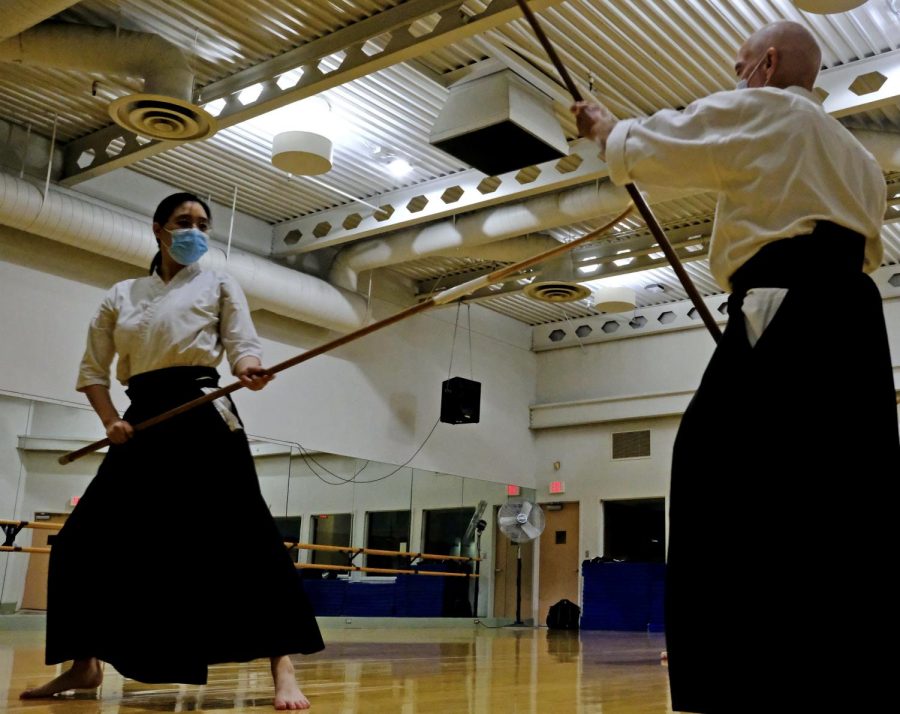
Kevin has tried to emulate Helen’s qualities as a teacher, such as being patient, understanding and demanding of his students. Through emulating her qualities he has noticed how that has improved his career as a teacher and when he was the U.S. coach for the world team.
“Nakano sensei exudes wisdom and confidence and an air of respect. So I think that by taking her class, a student who maybe has never picked up a weapon, would never have to face, really faced something and confront something, it can be quite fearful to face another person with a weapon,” Kevin says.
Having such a tool and being provided with an environment in which to practice it securely and with direction are things that Kevin believes will benefit someone with competence for the rest of their life.
“It’s kind of a wonderful experience to see people being able to improve in this beautiful art, some very elegant and powerful art form,” Helen says.
The greatest challenge Helen faced was the lack of teachers. Helen mentioned that there are so many different levels of students.
“You have a total beginner and then somebody that is more an intermediate student. Then you have your more advanced students and it’s trying to keep all of them engaged on the floor at the same time,” Helen says.
Helen faced an obstacle being the only instructor for a naginata course. However, she took that as an opportunity to teach all levels and keep them interested and spirited with the art.
Helen says that practicing naginata at the dojo was tough for new students because they were trying to learn all of the basic movements, including footwork, not only how to use their naginata, but also how to read, move their feet and move their bodies with a weapon.
“I would continue and encourage them. I didn’t want to see them get discouraged. I try to keep the beginner students focused,” Helen says.

Helen describes the two elements of naginata. The atarashi (new) naginata is one example. The naginata is fashioned of oak coal and has a bamboo tip. The blade is constructed of two bamboo strips bound together by a leather pano. It stands roughly 7 feet, 4 inches tall. It is a weapon that can be wielded with both hands.
The stance Helen incorporates with her students is called hanmi. When facing an opponent, you just use one side.
Helen says naginata has high regard for fellow practitioners. Particularly when performing on stage or in real life.
“It’s always to be respectful to the other person and I think that’s uppermost in my mind in teaching,” Helen says.
Helen had done her best to practice naginata amid the pandemic. She learned how to hold classes virtually through Zoom. She would practice alone in her backyard and the students would practice in their yards or homes.
“Because the weapon is such a long weapon it would be difficult to move the weapon inside of the house unless you have very tall ceilings. But I have a student or two that was able to actually do it inside, which was wonderful. I held class once a week on Thursdays, just as we would here normally at the Torrance dojo and it went quite well,” Helen says.
Helen had a married couple attend her classes. The couple, Grace Wu and Ruben Ramirez, were alumni from ECC. They were able to demonstrate to the beginners how a movement is made and the footwork that follows said Helen.

The students would start practicing in Torrance in mid-April. Helen had three students when they opened. After a few weeks followed the numbers increased.
Helen is unable to teach her class at ECC at the time. She taught her last class at ECC in the Spring of 2020. The dean informed her that she would most likely not be able to teach next term.
“I really miss teaching at El Camino College because I love the excitement and the enthusiasm with the new students that beginner students when they start taking my class there. And I’m hoping I can continue teaching despite my age. I’m still physically able to do most moves,” Helen says.
Helen reveals that her greatest concern about the pandemic is personal safety. When she was with family they would sit in the backyard and would keep their distance as a means to prevent exposing anyone to COVID-19.
“We didn’t want to get it and we didn’t want to spread it,” Helen says.
All of her family members were vaccinated as soon as the vaccine was released. Even in the dojo, the vast majority of them have been vaccinated.
“We’ve come to the point where everyone in the dojo is going to have to be vaccinated in order to practice,” Helen says.
Helen adds that another challenge practicing the ancient combat in the pandemic was the disadvantage of using voices. When practicing naginata a key element is Kiai or Chi, which is the act of using their voices to yell the name of the cut they are practicing.
The only person allowed to shout was the instructor. Other than that, no one else was permitted to yell.
“We all want to go back to normalcy again, but I don’t know when that’s going to be possible. But I feel the feelings of my students of wanting to get together, wanting to be able to practice this beautiful art together and continue to learn,” Helen says.

The students inspire Helen to continue practicing the art of naginata. Although it is difficult for beginner students to learn from scratch, the more competitive they become the more enthusiasm and joy grows within them.
“It’s very difficult to sometimes explain the feelings that go into doing this art form. But it’s very powerful,” Helen says.
Helen is a member of the International Naginata Federation. They used to gather every year, but due to the pandemic, they haven’t been able to do so. The most recent encounter took place in Germany in 2019, at the world championship.
“I’ve seen how Naginata has grown in all these years,” Helen says.
The International Naginata Federation started back in 1990. Helen has been involved since the beginning.
“The next championship for the world is supposed to be in the United States in 2023. But because of the pandemic, we’re not sure if that is going to happen,” Helen says.
Helen and her husband George were awarded the Order of the Rising Sun, Gold Rays with Rosette medal from Emperor Akihito of Japan himself. Helen had gone to Japan to accept her award.
“We’re so honored to have been recognized to receive the award. George had received his award (in 2005) when he turned 70 and then I received mine (in 2009) when I turned 70, as well,” Helen says.
Helen says if she was unable to teach she would miss it. It has become part of her life now, something she has been doing for more than a number of decades.

“I feel blessed that I’m able to physically go out on the floor and continue teaching. I have not come to the point yet, (where) I felt like I could not teach,” Helen says.
Helen has taught students internationally. She mentioned that she’s had students outside of ECC contact her.
“I have started naginata schools in Lincoln, Nebraska and then in Phoenix, Arizona, and actually in Tallahassee, Florida. So I’ve flown to different states personally, to teach by invitation,” Helen says.
Helen has taught naginata in South America. She has been to Italy to teach by invitation. Despite her teaching experience in other countries, Helen prefers to stay in California.
“Torrance is my home. I’ve lived in Torrance, California since 1965. Part of that was in Manhattan Beach. But when I teach in other countries or in other states, it’s by invitation usually, and I will go in and teach a seminar,” Helen says.
Helen discussed how there is a common assumption among people that instructors who teach naginata or kendo are paid, but they are not. When she travels to a different country she travels at her own expense.
“I am not paid to teach. I do not take any payment for teaching. The only place I am paid to teach is at ECC but when I teach in other countries or other states or here in California, I do not charge a fee for teaching. I teach because I love the art. I love it and I want to spread it,” Helen says.
Helen enjoys going out for lunches and attending family gatherings in her free time. She does not consider naginata a hobby, rather she considers it an art form. She is very fortunate that a majority of her students are now teaching in their own dojos. She feels very gratified that they’ll carry on after her.
“I would like to continue doing what I’m doing and hopefully we’re able to get through this pandemic and I can continue teaching. I really miss getting together and being together, in a dojo together and practicing without masks. I hope sometime in the near future we’re able to do that again,” Helen says.

Editor’s Notes:
- Story was updated for clarity on June 6, 2022, at 7:03 p.m.
- Photos were enlarged and video was added on Monday, June 26, 2023.


